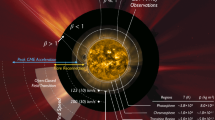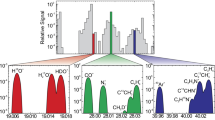Abstract
With the identification of a diffuse flux of astrophysical (“cosmic”) neutrinos in the TeV–PeV energy range, IceCube has opened a new window to the Universe. However, the corresponding cosmic landscape is still uncharted: so far, the observed flux does not show any clear association with known source classes. In the present talk, I sketch the way from Baikal-NT200 to IceCube and summarize IceCube’s recent astrophysics results. Finally, I describe the present projects to built even larger detectors: GVD in Lake Baikal, KM3NeT in the Mediterranean Sea and IceCube-Gen2 at the South Pole. These detectors will allow studying the high-energy neutrino sky in much more detail than the present arrays permit.












Similar content being viewed by others
REFERENCES
C. Spiering, Eur. Phys. J. H 37, 515 (2012).
M. G. Aartsen et al. (IceCube Collab.), Science 342, 1242856 (2013).
S. Adrián-Martínez et al. (KM3NeT Collab.), J. Phys. G 43, 084001 (2016).
A. Avronin et al. (Baikal Collab.), Phys. Part. Nucl. 46, 211 (2015).
M. G. Aartsen et al. (IceCube Collab.), arXiv:1412.5106.
M. G. Aartsen et al. (IceCube Collab.), Astrophys. J. 835, 151 (2017).
R. Balkanov et al. (Baikal Collab.), Astropart. Phys. 12, 75 (1997).
I. Belolaptikov and C. Spiering, Baikal-Amanda Internal report, 2005.
P. Coyle and C. W. James, arXiv:1701.02144.
M. G. Aartsen et al. (IceCube Collab.), JINST 12 (3) P03012 (2017).
P. Lipari, Nucl. Instrum. Methods A 567, 405 (2006).
M. G. Aartsen et al., Phys. Rev. Lett. 111, 021103 (2013).
C. Kopper (IceCube Collab.), ICRC (2017).
M. G. Aartsen et al. (IceCube Collab.) Astrophys. J. 833, 3 (2016).
C. Haack and C. Wiebusch (IceCube Collab.), ICRC (2017).
M. G. Aartsen et al. (IceCube Collab.), Astrophys. J. 808, 98 (2015).
S. Adrián-Martínez et al. (ANTARES Collab.), Astrophys. J. 786, L5 (2014).
D. Gaggero, D. Grasso, A. Marinelli, A. Urbano, and M. Valliet, Astrophys. J. 815, L25 (2015).
C. Haack and J. Dumm (IceCube Collab.), ICRC (2017).
M. Petropoulou, S. Dimitrakoudis, P. Padovani, A. Mastichiadis, and E. Resconi, Mon. Not. R. Astron. Soc. 448, 2412 (2015).
M. Huber and K. Krings (IceCube Collab.), ICRC (2017).
M. G. Aartsen et al. (IceCube Collab.), Astrophys. J. 843, 112 (2017).
M. Ahlers, M. Gonzalez-Garcia, and F. Halzen, Astropart. Phys. 35, 87 (2011).
E. Waxmann and J. Bahcall, Phys. Rev. Lett. 78, 2292 (1997).
R.Abbasi et al. (IceCube Collab.), Astron. Astrophys. 535, A109 (2011).
http://snews.bnl.gov/.
E. Blaufuss (IceCube Collab.), ICRC (2017);
M. G. Aartsen et al. (IceCube Collab.), Astrophys. J. 811, 52 (2015).
S. Adrián-Martínez et al. (ANTARES, TAROT, ROTSE, Swift and Zadko Collab.), JCAP 1602 (2) 062 (2016).
https://gcngsfc.nasa.gov/. http://amon.gravity.psu.edu/.
M. G. Aartsen et al. (IceCube, PTF, SWIFT Collab.), Astrophys. J. 811, 52 (2015).
M. G. Aartsen et al. (IceCube Collab.), arXiv:1702.06131.
M. Albert et al. (ANTARES, IceCube Collab.), arXiv:1703.06298.
V. Berezinsky and G. Zatsepin, Yad. Fiz. 11, 200 (1970).
Zh. Djilkibaev (Baikal Collab.), ICRC (2017).
http://www.globalneutrinonetwork.org/.
S. Adrián-Martínez et al., Astrophys. J. 823, 65 (2016).
Author information
Authors and Affiliations
Corresponding author
Additional information
The article is published in the original.
Rights and permissions
About this article
Cite this article
Spiering, C. High Energy Neutrino Astronomy: Where Do We Stand, Where Do We Go?. Phys. Part. Nuclei 49, 497–507 (2018). https://doi.org/10.1134/S1063779618040536
Published:
Issue Date:
DOI: https://doi.org/10.1134/S1063779618040536




